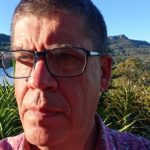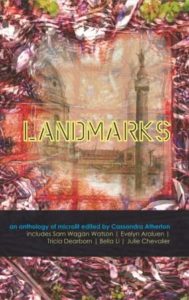 This week we talk with prose poet, Tim Heffernan, whose recent work ‘Barunga Conversation’ appears in Landmarks – the latest anthology curated by Spineless Wonders. During this interview we discover Tim’s favourite Australian landscape, who inspires his writing and what inspired his poem, ‘Barunga Conversation.’
This week we talk with prose poet, Tim Heffernan, whose recent work ‘Barunga Conversation’ appears in Landmarks – the latest anthology curated by Spineless Wonders. During this interview we discover Tim’s favourite Australian landscape, who inspires his writing and what inspired his poem, ‘Barunga Conversation.’
Tell us about a landmark that is significant to you
Where I live, in Balgownie, near Wollongong, we look west to the Illawarra escarpment and east to the Pacific Ocean, so in that there is one nurturing, cradling landmark and then the place where we leave the land and make our marks in the water. But I’m not a natural littoral person, I am not of the sea, I am river.
My most significant landmark is the Murrumbidgee River. I was born in Hay, NSW, and made my way upstream to Wagga Wagga and then Cooma. I probably should live in Adelaide where it all spills to the sea. I love the way rivers can unload their sand on the convex beaches and cut away at the land on the concave. I often drifted from ‘The rocks’ downstream to Wagga beach, and I always felt moved by the current.
What inspired you to write ‘Barunga Conversation’?
Many of our Prime Ministers have attempted reconciliation with the people who own this land that we stole. In 1988 it was Bob Hawke. Amongst others we’ve had Paul Keating’s Redfern address, Rudd’s apology and Abbott’s indigenous cabinets. This poem began in 1988, but it came back to me when I shared a Garma Festival with the Yolngu, Bob and significant others in 2015. The Yolngu love what Bob did then, but in the context of Recognition and Treaty, I thought it was timely to re-invent this poem. I worry about all the words we use, all the words we use to distract people from the nothing happening.
We are illegal occupants of Aboriginal land. We need more than long sentences that just hold us in the same old paragraph and I hope that my prose poetry is concrete and accountable.
How do you find the experience of writing to a theme?
I love it! Love the way it allows me to re-invent previous failure, while also being new. It’s not artificial. I often reflect on writing compositions in primary school when my father, John Heffernan, was my teacher. Sometimes a theme will release a dream. Thanks dad x.

Describe your writing space
I write in my head, so I mostly carry that with me. Even more frequently than mostly, at home, I write downstairs at a computer in the lounge room while my family watch TV. I feel I need to be close. I have a study upstairs that looks out to the sea, and write and think lots there too.
Mostly I write while I am doing things, in the garden, at work, and when I am with people. First drafts usually been with an intrusive thought, a word, a line, a sentence.
Tell us about a writer or work that has inspired you as a writer
I’ve been inspired by so many. Once, when I was mad, Anais Nin spoke to me from a stitched in quote from a dinner jacket, “Life shrinks or expands in proportion to one’s courage”. Keats, Coleridge, Kurt Vonnegut, Charles Bukowski, Isaac Asimov, Thea Astley, Elizabeth Jolly, Peter Kocan and David Ireland are a few I can think of who have encouraged me to expand.
Truly, my friend Mark Miller has been the most inspiring writer. I taught with Mark in 1989 when he released his first book of poems, ‘Conversing with Stones’. Mark continues to teach me the essential things about poetry,
‘here, nothing else matters
but the sound
of my own breathing,
and my footsteps
taking me onwards.’
– Mark Miller, Haven.
That is poetry.
Tim Heffernan lives in the foothills of the Illawarra Escarpment in a village called Balgownie. He has been shortlisted for the joanne burns award in 2015 & 2016. As well as prose poetry and micro fiction Tim has an interest in Mad Poetry, hosting a workshop and panel at the 2016 Wollongong Writers Festival.
Feature image via Parliament of Australia website

